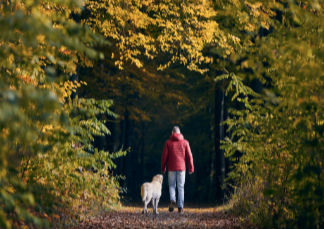7 Essential Dog Grooming Tips to Prepare Your Pup for Cooler Weather
- Mary Augustine

- Sep 11
- 4 min read

As the crisp air of fall rolls in, it's time to adjust your dog's grooming routine for the upcoming cooler weather. Just like humans, dogs need special care to stay healthy and comfortable when temperatures drop. Whether you have a short-haired dog or a long-haired breed, taking a few extra steps now will help your furry friend navigate the cooler months with ease. Here's a guide with seven essential grooming tips to keep your dog happy and healthy during fall and winter.
1. Brush Regularly to Avoid Mats and Tangled Fur
Why it’s important: As the weather cools, your dog’s coat may begin to thicken, leading to

mats and tangles that can trap moisture and irritate their skin. Regular brushing is essential to keep their coat healthy and comfortable.
What to do: Depending on your dog's coat type, brush them a few times a week to prevent mats. For long-haired breeds, you may need to brush daily to avoid tangles. Be sure to use the right brush for your dog’s coat—slicker brushes work well for long-haired breeds, while short-haired dogs benefit from bristle brushes or rubber grooming mitts.
2. Trim Nails to Prevent Slippery Falls

Why it’s important: Longer nails can make it difficult for dogs to grip icy or slick surfaces,
which increases the risk of falls during outdoor activities. Short nails are not only safer, but they also help your dog move more comfortably.
What to do: Check your dog’s nails regularly, especially as they spend more time indoors during the colder months. Trim them every 2-4 weeks or as needed. If you’re unsure how to trim their nails, consider taking them to a professional groomer or your vet. And don’t forget to check for cracks or splits, which are more common during the dry winter months.
3. Keep Ears Clean and Dry
Why it’s important: Moisture from wet walks, baths, or the damp weather can lead to ear
infections, especially in breeds with floppy ears, like Cocker Spaniels or Basset Hounds. Keeping ears dry and clean will prevent discomfort and infections.

What to do: After walks in wet weather, gently dry your dog’s ears with a soft towel. For breeds prone to ear infections, use a dog-safe ear cleaner to remove any excess wax and debris. You can also schedule regular ear checks during grooming sessions to catch any early signs of infection, such as redness, discharge, or foul odor.
4. Adjust Bathing Routine for Seasonal Coat Changes
Why it’s important: Dogs may shed more during the fall and winter months as their undercoat thickens, and their skin can become drier due to the colder, drier air. Over-bathing can strip their coat of natural oils, leading to dryness and irritation.

What to do: Reduce the frequency of baths and stick to a grooming schedule that works for your dog. Generally, you should bathe your dog every 4-6 weeks, but this varies by breed. Use a moisturizing dog shampoo to maintain a healthy coat and skin. If your dog spends a lot of time outdoors, consider wiping them down with dog-friendly wipes after walks to remove dirt and debris.
5. Protect Their Paws from Harsh Weather

Why it’s important: Dogs’ paw pads can become dry, cracked, and even irritated from the cold ground, ice, and snow. Salt used on sidewalks can also be harmful to their paws. Keeping their paws healthy is essential for safe and comfortable outdoor excursions.
What to do: Trim the hair around the paws to avoid ice and snow buildup. Apply paw balm regularly to protect the paw pads from becoming dry or cracked. You can also use booties to protect their paws during walks, particularly if you live in an area that uses salt or de-icers on roads and sidewalks. After walks, wipe their paws to remove any salt or debris.
Dress Your Dog for the Weather

Why It’s Important: Not all dogs have thick fur to protect them from the cold. Short-haired breeds, puppies, small dogs, and senior pets can lose body heat quickly, making them more vulnerable to hypothermia.
What to Do: Invest in a warm, snug-fitting dog sweater or coat for chilly walks. Choose one that covers your dog’s neck and belly but still allows them to move freely. Avoid overly bulky materials, and always remove wet or damp clothing when coming back indoors.
7. Consider a Fall Grooming Cut for Longer-Haired Breeds
Why it’s important: Long-haired breeds often require more maintenance to keep their coats

manageable during the cooler months. A fall trim can help prevent mats and tangles, and it also makes managing their coat easier as they adjust to the season.
What to do: Consider giving your long-haired dog a trim that’s more suitable for the cooler months. A shorter coat will be easier to manage and keep clean, especially if your dog enjoys outdoor activities. If you’re unsure about how much to trim, consult a professional groomer for guidance on the best cut for your breed. Be sure not to trim too short—dogs still need insulation against the cold.
Final Thoughts

Regular brushing, trimming nails, and maintaining clean ears and paws will ensure your dog stays happy and healthy as the weather changes. Remember to keep an eye on your dog’s coat and skin health, as the cold air can cause dryness or irritation. If you're ever in doubt, don't hesitate to consult with your veterinarian or a professional groomer to ensure you're providing the best care for your dog as the seasons shift. Hopefully, you and your dog will be ready to enjoy everything the cooler months have to offer—whether it’s cozy naps by the fire or adventurous walks through the autumn leaves.
-Written by Mary Augustine
Owner of Pets & Plants





.png)
.png)



Comments